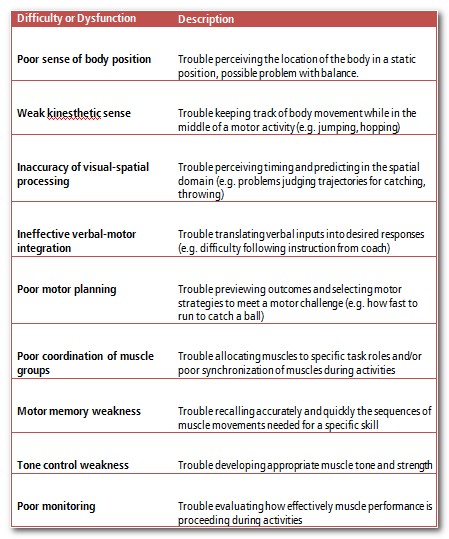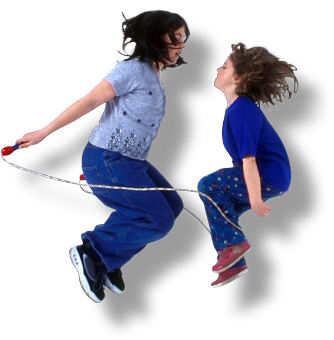Gross motor skills
| Gross Motor Skills | Major Indications |
| Gross Motor Problems | Implications |
Gross motor skills are the use of large muscles in a co-ordinated manner. These physical skills are evident in such activities as dance, physical games and accomplishing a range of other life activities.
To perform adequately in common large movement physical activity a person must be able to form judgments regarding various kinds of incoming data (gathered from their sight, hearing, balance, etc.) and respond quickly with appropriate and accurate large muscle movements.
During the gross motor activity the person must then make use of ongoing sensory feedback (i.e. balance) to continue the activity successfully.
Gross motor memory is vital at this time as it allows a person to recall the muscular steps used in the past for successful completion of the activity or performance (e.g. dance). Numerous muscles and muscles groups must be properly and quickly brought into use, e.g. in dance so that the right muscle groups are accomplishing the appropriate necessary steps at the right time. For some persons these processes can be nearly instinctive and for other continual training and discipline will be required.
| Frequently Asked Questions about Gross Motor Skills |
The general gross motor difficulties experienced within school settings are summarised below:

Source: http://ldonline.org/ld_indepth/parenting/motor_levine.html
Major indicators
Gross motor development is generally most evident in the very young, i.e. from birth to 5 years. It will continued to be a factor in the early years of schooling and then after about the fifth year of schooling becomes more associated with those leareners who have physical impairments or developmental delays.
| Here are a some examples of indicators of 'average' motor development you may expect across the very early years of childhood. |
Implications for learning/teaching teams
When working in the early years of both formal and informal learning (i.e. schools and childcare respectively) it is vital that the learning and play programs provide experiences that support gross motor skill development.
The type of physical movements that should be encouraged and planned for in play and learning activities include:
Balancing |
Hanging |
Pulling |
Swaying |
Bouncing |
Hopping |
Punching |
Stretching |
Bending |
Hitting |
Running |
Swinging |
Crawling |
Jumping |
Rolling |
Twisting |
Climbing |
Kicking |
Sliding |
Turning |
Curling |
Leaping |
Shaking |
Tumbling |
Catching |
Lifting |
Skipping |
Throwing |
Galloping |
Pushing |
Stepping |
Walking |
Activities like those suggested below are vital for early development of gross motor skills:
Balancing
These activities develop control and coordination through two - sided activity.
| 1. | Walk along chalk line, string line or narrow board. |
| 2. | Alternate feet inside large shape. Decrease as children become more skilled. |
| 3. | Use a balance beam. Vary the levels (inclined, declined), type of board, etc. |
| 4. | Following tiny tracks, i.e. paths made from placing unit blocks, carpet strips, etc. |
| 5. | Climbing steps/ stairs/ step ladders and walking on knees with hands in the air. |
Crawling
These types of activities help develop coordination, laterality, and synchronization of right and left body sides.
| 1. | Crawl through an obstacle course - through (boxes, tyres, pipes, hoops, tunnel) under objects (table, large fixed equipment, rug/sheet, chairs, rope, ladder) around objects (tree, box, chair, fixed apparatus) over objects (pillow, box, mattress, mat.) |
| 2. | "Follow the line," set up a string line or chalk line for children to crawl along. |
| 3. | Treasure Hunt - crawl to find hidden objects |
| 4. | "Follow the leader," crawl behind someone, create an obstacle course. |
| 5. | "Floor map," crawl over large floor map with roads, rivers, etc. |
Climbing
These activities strengthen muscles, develops posture and gives opportunities for viewing environment from different perspectives.
| 1. | Up/down steps |
| 2. | Climb over, up, down boxes, ladders, planks, logs, etc. |
| 3. | Along an obstacle course using a variety of equipment of differing heights etc. |
Hopping
These type of activities assist in gaining body control and balance.
| 1. | Hop into/out of hoops |
| 2. | Around obstacles - boxes, trees, reels, tyres, fixed equipment hoops |
| 3. | Hop along stepping stones |
| 4. | Make patterns on the ground of shapes, colors, dots. Hop on one color,dot etc |
| 5. | Ladder painted on ground - children hop along it |
Jumping (develops overall gross motor skills - coordination)
| 1. | Jumping obstacle course, low boards, string, blocks, logs, boxes etc. |
| 2. | Over objects - string, line, magazine, bean bag |
| 3. | Jump up to touch/reach suspended objects, leaves, balloons, toy etc. |
| 4. | Stand and jump from one pace to another, from shape to shape |
| 5. | Jump on mattresses, tyres, large tractor tubes, trampolines |
Kicking
These activities support the development of...
| 1. | Balls of different sizes |
| 2. | Balloons |
| 3. | Aim at a target - set up target areas for children to kick at e.g. "bulls eye" |
Pushing - Pulling
These activities help develop control over body joints and in external objects.
| 1. | Tug of war |
| 2. | Pushing boxes and toys |
Rolling
Body rolling develops awareness of relationship between upper and lower body and pivot points of neck and feet. Rolling objects assist in developing coordination.
| 1. | Balls using hand/s |
| 2. | Balls using feet/foot |
| 3. | Hoop using hands |
| 4. | Body on mat - 'log rolling' forward, backward rolls. |
Running
| 1. | Around a track or between two points |
| 2. | Around an obstacle course |
| 3. | On the spot/on the toes |
| 4. | With hands on head/hips/behind back etc. |
Skipping
| 1. | Around objects and between two points |
| 2. | In circle games |
| 3. | To music with variety of rhythms |

| 1. | Use different body parts as a base |
| 2. | Inside hoop - turn, twist, bend to reach things outside hoop |
| 3. | Doing 'tricks' inside a hoop/on a mat |
| 4. | Using mats for somersaults, rolling etc. |
Walking/stepping
| 1. | In and out of circles, hoops, tyres, outlines |
| 2. | Along a line (chalk), piece of string etc. |
| 3. | On wide surfaces gradually becoming narrower |
| 4. | Use a rope or string to guide children through a maze |
| 5. | Walking to different music tempos |
| 6. | Following cut outs or painted footsteps etc. |